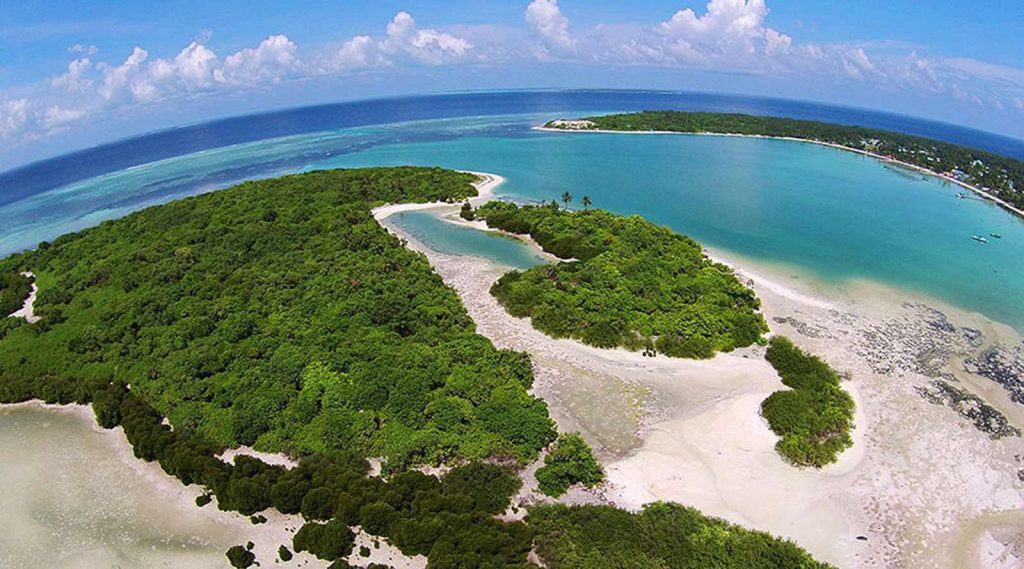
As you cruise on the surface of the water in the mangrove swamp of Baarah Island, you can observe a mesmerizing ecosystem—a complete immersion into breathtaking nature. HA. Baarah is located on the eastern rim of HA. Atoll at 6° 49.010’N and 73° 12.778’E. The island has a land area of 248.8 ha. On the eastern side of the island, 10 different areas of mangroves and wetlands are located. On this island, around 39 hectares are mangroves.
Baarah Island has unique geographical formations. It’s an island with breathtaking ecosystems holding vast mangroves full of life. From vibrant birds to thick vegetation, this island has a distinct structural complexity. Birds look out sharply from tree perches; their white feathers are arranged like cloaks. Grey herons, cattle egrets, western cattle egrets, Indian pond herons, whimbrels, and sandpipers rest, roost, and feed in the mangroves. Flamingos, ruddy turnstones, lesser golden plovers, and common greenshanks are frequent visitors.
Aves hunt for insects and enjoy the vast wetland areas. Mangrove crabs, hermit crabs, and tree ants reside in the ecosystem. The water body in the mangrove is directly linked to the lagoon. Hence, stingrays, young sharks, turtles, ghost shrimp, Congo eels, and juvenile reef fish inhabit the area. Crustaceans are also present in this ecosystem. Mangrove plants that are found here are Rhizophora mucronata (Ran’doo), Ceriops tagal (Kanamana), Lumnitzera racemosa (Burevi), Rhizophora apiculata (Thakafathi), Bruguiera cylindrica (Kan’doo) and Excoecaria agallocha (Thela).
This is an ecosystem for some of the majestic birds. The wading bird flamingo is a visitor. The long legs and striking pink plumage of this beautiful bird have captivated many Maldivians. You can observe the symbiotic nature of vegetation and trees. Experiencing a mangrove swamp can be a surreal experience.
Perhaps we may feel that it is a thick vegetation with silent water bodies. But it is vibrant and lively. The branches of these mangroves quiver as birds forage for fruit and food. You hear a distant hum: insects tirelessly hovering around. The shelter here is dense, but sunlight filters through the leaves. Herons wade forward as they swing their heads from left to right, sifting through the mud with their bills. Lizards skim over the grass.
Beneath the water, fishes move and hide in the mud and under the roots of trees. Juvenile tarpons move silently through the water. Crabs scramble furtively, trying to avoid detection. At night, attracted by the scent of mangrove flowers, bats fly speedily toward their next drink.
Mangroves are teeming with life both above and below the water. It is critical to coastal ecosystems; they provide a nursery for many freshwater species. Their tangled roots offer refuge to fish, crustaceans, and mollusks.
Mangroves protect us. They help prevent erosion and reduce flooding by retaining soil and water. Mangroves also trap pollutants and sediment and therefore increase the quality of the surrounding waters, acting as a natural filtration system.
Mangroves are pristine. It’s a beauty that is vivid. Some plants of this mangrove are magical. They appear green and sometimes as if they are dyed yellow, resembling the appearance of autumn. In this mangrove, most notably during the northeast monsoon, leaves of some plants change color to yellow. Excoecaria agallocha (Thela) is notably the plant that has this distinct feature. This is perhaps the plants shedding their old leaves. Some common names of this plant are Blind-Your-Eyes, Buta-Buta, Bebuta and Milky Mangrove.
When the leaves turn yellow, this mangrove is covered with a brilliant array of yellow leaves, serving to create a peaceful scene. It turns the place into a brilliant picture of autumn. When the yellow colors of the trees interlace with rays of sunshine and fresh air, it gives a feeling of relaxation and peace of mind.
It is a fascinating experience to explore every nook and cranny, venturing through clusters of these towering mangroves that depict gorgeous scenery, with its soft colors and tranquil atmosphere. The atmosphere is quiet enough to hear the chirping of birds. Fish dart under the water. The sounds of birds, insects, and aquatic animals soothe the mind. The symphony encapsulates the vibrant life of nature.
